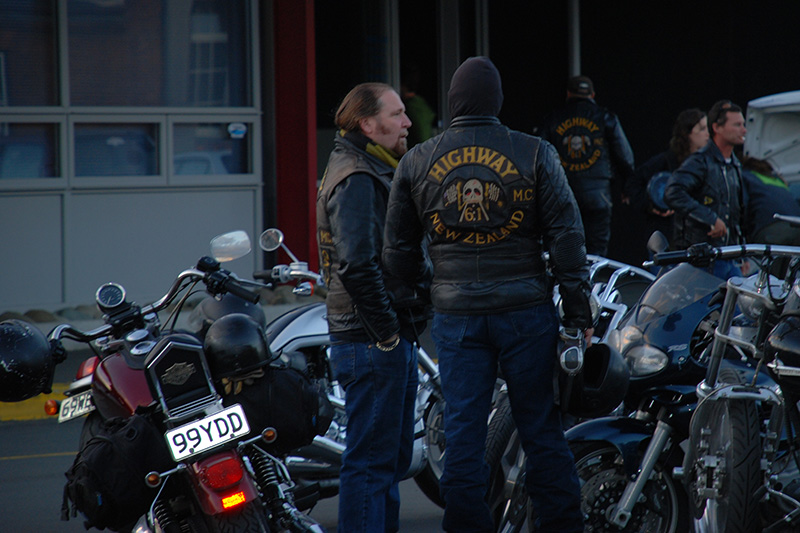The Government also promises extra police powers to search for guns, and to make gang membership an aggravating feature at sentencing.
The new Coalition Government has made its campaign promise to crack down on gangs a priority in its 100-day action plan. But whether the new ‘get tough’ policy genuinely plugs gaps in existing legislation is very much open to question.
The policy was laid out in a letter of expectations to the Police Commissioner from new Police Minister Mark Mitchell in early December, including: banning gang patches in public, stopping public gang meetings, and preventing gang members communicating with each other.
The Government also promises extra police powers to search for guns, and to make gang membership an aggravating feature at sentencing.
We all have a right to be safe from harm, including harm by gangs. But there are already many relevant offences in the law that exist to protect the general public.
No need for new law
First, it is already an offence to be in a criminal gang. Section 98A of the Crimes Act 1961 allows up to 10 years’ imprisonment for participating in an “organised criminal group”. This involves three or more people who aim to commit serious violence, or who benefit from offending, liable for at least four years’ imprisonment.
As with most serious criminal offences, a guilty mind is required: you have to know it is a criminal group, realise your involvement might contribute to criminal activity, and also be aware the criminal activity might help the criminal group.
It is also a criminal conspiracy to agree to commit offences. And our ‘joint enterprise’ law in section 66(2) of the Crimes Act means those who agree to commit one offence are also guilty of other foreseeable offences committed by the group.
There are also many offences against public order in the Summary Offences Act 1981, including disorderly or offensive behaviour, and associating with those convicted of theft, violence or drugs offending.
As well, there is the Prohibition of Gang Insignia in Government Premises Act 2013. This bans gang insignia in or on premises operated by central and local government, including schools, hospitals and swimming pools, but not Kāinga Ora housing.
Guns and gangs
If arresting our way out of a problem works, there are already many criminal justice tools. We should also note that the apparent growth in gang membership has occurred despite these various offences and powers.
The Arms Act 1983 makes the privilege of obtaining a firearms licence dependent on being a “fit and proper person”; gang membership and convictions already mean this test is not met.
Section 18 of the Search and Surveillance Act 2012 allows the police to search any person or place if they reasonably suspect a breach of the Arms Act.
And when it comes to sentencing, section 9(1) of the Sentencing Act 2002 already requires judges to consider an offence to be worse if committed as part of organised criminal activity.
The Criminal Proceeds (Recovery) Act 2009 allows the seizure of criminal gains even if there has not been a conviction.
In short, if arresting our way out of a problem works, there are already many criminal justice tools. We should also note that the apparent growth in gang membership has occurred despite these various offences and powers.
Rights and their limits
We also need to ask whether the new anti-gang measures breach fundamental principles such as human rights. These are part of New Zealand law, through the New Zealand Bill of Rights Act 1990 and the common law. They also reflect international standards that New Zealand has agreed to respect.
Everyone has the right to freedom of expression, which includes proclaiming gang affiliation. There is also the right to associate with others, and to assemble peacefully.
But all of these rights have to be balanced against other interests. The Bill of Rights Act sums this up by allowing “reasonable limits” that “can be demonstrably justified in a free and democratic society”.
Essentially, legislation that restricts rights requires a legitimate purpose. This is usually easy to show. But it is also necessary to consider whether such restrictions work and do so in a way that is proportionate to the breach of rights.
Essentially, legislation that restricts rights requires a legitimate purpose. This is usually easy to show. But it is also necessary to consider whether such restrictions work and do so in a way that is proportionate to the breach of rights.
We have an idea what the courts might say. For example, in Morse v Police, the Supreme Court decided burning the New Zealand flag during an Anzac Day parade to protest New Zealand involvement in Afghanistan was not offensive behaviour, because it did not go beyond what people should be expected to tolerate in a democracy.
And in Schubert v Wanganui District Council, the High Court decided the ban on gang patches in all public places in the district went too far; the evidence did not show that something more tailored would have been as effective.
Tackling membership is the challenge
The Government might suggest its main aim is to extend the 2013 legislation banning gang patches in government premises to all public places. But that legislation is probably acceptable because it has limits.
The Bill of Rights Act also protects against discrimination. Here we have to recall that Māori are disproportionately imprisoned, and disproportionately affected by socioeconomic factors (including abuse in state care and incarceration) that seem linked to gang recruitment.
Since it is likely that action against gangs will affect Māori to a greater extent, a Waitangi Tribunal claim may be expected.
We should be mindful that criminal justice powers represent an ambulance at the bottom of the cliff. People’s right to be safe is more likely to be secured by other steps that turn people away from gang membership in the first place.
To abide by existing human rights provisions in the law, the Government will need to craft various exceptions to the ban on gang patches, or to people meeting or communicating with each other.
Alternatively, if it is comfortable with breaches of human rights, it can make that clear. This is possible because the Bill of Rights Act can be sidestepped by parliament using legislative language that precludes consistency with such rights.
This would still leave the law in breach of New Zealand’s international obligations, with resulting reputational damage.
But we should also be mindful that criminal justice powers represent an ambulance at the bottom of the cliff. People’s right to be safe is more likely to be secured by other steps that turn people away from gang membership in the first place.
This article first appeared on The Conversation, and is republished under a Creative Commons Licence; the original can be read here.
About the Author
 Kris Gledhill is Professor of Law at Auckland University of Technology; his more than 30 years in the law, as both a practitioner and an academic, has spanned many aspects of law but has focused on criminal law and human rights law, particularly international human rights. As a barrister in London he largely worked as a criminal lawyer and representing the rights of detained people. Although he had always contributed to academia through teaching, journal articles and books, he became a full-time academic when he and his family moved to New Zealand in the mid-2000s to a role at AUT.
Kris Gledhill is Professor of Law at Auckland University of Technology; his more than 30 years in the law, as both a practitioner and an academic, has spanned many aspects of law but has focused on criminal law and human rights law, particularly international human rights. As a barrister in London he largely worked as a criminal lawyer and representing the rights of detained people. Although he had always contributed to academia through teaching, journal articles and books, he became a full-time academic when he and his family moved to New Zealand in the mid-2000s to a role at AUT.
Picture © Occulist / Wikipedia



Interesting read. The article doesn’t depict the problem they are trying to solve though? The picture shows gangs on motorcycles, is this the kind of gangs that are an issue in New Zealand or was it a stock photo?
Hi rc23572, thanks for the comment, and glad you found the article an interesting read. The picture is a stock photo; it shows members of New Zealand’s Highway 61 motorcycle gang, which is still listed among the country’s main outlaw motorcycle gangs (although others such as the Mongrel Mob and the Head Hunters have become more notorious in recent years). The measures to tackle the gang culture in New Zealand would seem to be targeted at outlaw motorcycle gangs, which are a significant problem in the country; the Ministerial Expectations letter refers to gangs ‘taking over public roads and spaces’, and the existing legislation prohibiting the wearing of gang insignia sets out 34 gangs whose ‘patches’ are banned from public offices, all of which are motorcycle gangs, which suggests that it is the motorcycle gangs that are the target of the new measures.
Thanks again for your interest, and for your comment.